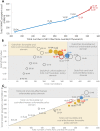A Reevaluation of the Voluntary Medical Male Circumcision Scale-Up Plan in Zimbabwe
- PMID: 26529596
- PMCID: PMC4646702
- DOI: 10.1371/journal.pone.0140818
A Reevaluation of the Voluntary Medical Male Circumcision Scale-Up Plan in Zimbabwe
Abstract
Background: The voluntary medical male circumcision (VMMC) program in Zimbabwe aims to circumcise 80% of males aged 13-29 by 2017. We assessed the impact of actual VMMC scale-up to date and evaluated the impact of potential alterations to the program to enhance program efficiency, through prioritization of subpopulations.
Methods and findings: We implemented a recently developed analytical approach: the age-structured mathematical (ASM) model and accompanying three-level conceptual framework to assess the impact of VMMC as an intervention. By September 2014, 364,185 males were circumcised, an initiative that is estimated to avert 40,301 HIV infections by 2025. Through age-group prioritization, the number of VMMCs needed to avert one infection (effectiveness) ranged between ten (20-24 age-group) and 53 (45-49 age-group). The cost per infection averted ranged between $811 (20-24 age-group) and $5,518 (45-49 age-group). By 2025, the largest reductions in HIV incidence rate (up to 27%) were achieved by prioritizing 10-14, 15-19, or 20-24 year old. The greatest program efficiency was achieved by prioritizing 15-24, 15-29, or 15-34 year old. Prioritizing males 13-29 year old was programmatically efficient, but slightly inferior to the 15-24, 15-29, or 15-34 age groups. Through geographic prioritization, effectiveness varied from 9-12 VMMCs per infection averted across provinces. Through risk-group prioritization, effectiveness ranged from one (highest sexual risk-group) to 60 (lowest sexual risk-group) VMMCs per infection averted.
Conclusion: The current VMMC program plan in Zimbabwe is targeting an efficient and impactful age bracket (13-29 year old), but program efficiency can be improved by prioritizing a subset of males for demand creation and service availability. The greatest program efficiency can be attained by prioritizing young sexually active males and males whose sexual behavior puts them at higher risk for acquiring HIV.
Conflict of interest statement
Figures




Similar articles
-
Could Circumcision of HIV-Positive Males Benefit Voluntary Medical Male Circumcision Programs in Africa? Mathematical Modeling Analysis.PLoS One. 2017 Jan 24;12(1):e0170641. doi: 10.1371/journal.pone.0170641. eCollection 2017. PLoS One. 2017. PMID: 28118387 Free PMC article.
-
Investigating Voluntary Medical Male Circumcision Program Efficiency Gains through Subpopulation Prioritization: Insights from Application to Zambia.PLoS One. 2015 Dec 30;10(12):e0145729. doi: 10.1371/journal.pone.0145729. eCollection 2015. PLoS One. 2015. PMID: 26716442 Free PMC article.
-
Modeling Impact and Cost-Effectiveness of Increased Efforts to Attract Voluntary Medical Male Circumcision Clients Ages 20-29 in Zimbabwe.PLoS One. 2016 Oct 26;11(10):e0164144. doi: 10.1371/journal.pone.0164144. eCollection 2016. PLoS One. 2016. PMID: 27783637 Free PMC article.
-
Voluntary Medical Male Circumcision to Prevent HIV: Modelling Age Prioritization in Namibia.AIDS Behav. 2019 Sep;23(Suppl 2):195-205. doi: 10.1007/s10461-019-02556-y. AIDS Behav. 2019. PMID: 31214866 Free PMC article. Review.
-
Using mathematical modeling to inform health policy: A case study from voluntary medical male circumcision scale-up in eastern and southern Africa and proposed framework for success.PLoS One. 2019 Mar 18;14(3):e0213605. doi: 10.1371/journal.pone.0213605. eCollection 2019. PLoS One. 2019. PMID: 30883583 Free PMC article. Review.
Cited by
-
Could Circumcision of HIV-Positive Males Benefit Voluntary Medical Male Circumcision Programs in Africa? Mathematical Modeling Analysis.PLoS One. 2017 Jan 24;12(1):e0170641. doi: 10.1371/journal.pone.0170641. eCollection 2017. PLoS One. 2017. PMID: 28118387 Free PMC article.
-
Cost and Cost-Effectiveness of a Demand Creation Intervention to Increase Uptake of Voluntary Medical Male Circumcision in Tanzania: Spending More to Spend Less.J Acquir Immune Defic Syndr. 2018 Jul 1;78(3):291-299. doi: 10.1097/QAI.0000000000001682. J Acquir Immune Defic Syndr. 2018. PMID: 29557854 Free PMC article. Clinical Trial.
-
Does infection with Chlamydia trachomatis induce long-lasting partial immunity? Insights from mathematical modelling.Sex Transm Infect. 2019 Mar;95(2):115-121. doi: 10.1136/sextrans-2018-053543. Epub 2018 Sep 4. Sex Transm Infect. 2019. PMID: 30181327 Free PMC article.
-
Effectiveness of an intervention to increase uptake of voluntary medical male circumcision among men with sexually transmitted infections in Malawi: a preinterventional and postinterventional study.BMJ Open. 2023 Oct 3;13(10):e072855. doi: 10.1136/bmjopen-2023-072855. BMJ Open. 2023. PMID: 37788927 Free PMC article.
-
Voluntary Medical Male Circumcision for HIV Prevention in Malawi: Modeling the Impact and Cost of Focusing the Program by Client Age and Geography.PLoS One. 2016 Jul 13;11(7):e0156521. doi: 10.1371/journal.pone.0156521. eCollection 2016. PLoS One. 2016. PMID: 27410474 Free PMC article.
References
-
- World Health Organization (WHO). Joint strategic action framework to accelerate the scale-up of voluntary medical male circumcision for HIV prevention in Eastern and Southern Africa. Geneva: 2011.
-
- WHO and Joint United Nations Programme on HIV/AIDS (UNAIDS). New data on male circumcision and HIV prevention: policy and programme implications WHO/UNAIDS technical consultation on male circumcision and HIV prevention: research implications for policy and programming. Geneva, Switzerland: WHO; March 6–8, 2007.
-
- Zimbabwe National Statistics Agency (ZIMSTAT) and ICF International. Zimbabwe Demographic and Health Survey 2010–2011. Calverton, Maryland: ZIMSTAT and ICF International Inc., 2012. Available: http://dhsprogram.com/pubs/pdf/FR254/FR254.pdf. Accessed 2015 Apr 12.
-
- Njeuhmeli E, Forsythe S, Reed J, Opuni M, Bollinger L, Heard N, et al. Voluntary medical male circumcision: modeling the impact and cost of expanding male circumcision for HIV prevention in eastern and southern Africa. PLoS Med. 2011;8(11):e1001132 Epub 2011/12/06. 10.1371/journal.pmed.1001132 - DOI - PMC - PubMed
-
- U.S. President's Emergency Plan for AIDS Relief (PEPFAR). Zimbabwe Operational Plan Report FY 2010. [Washington]: PEPFAR 2010. Available: http://www.pepfar.gov/documents/organization/145742.pdf. Accessed 2015 Apr 12.
Publication types
MeSH terms
LinkOut - more resources
Full Text Sources
Other Literature Sources
Medical

